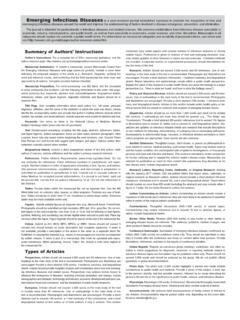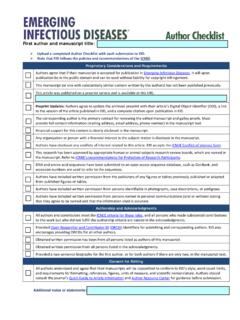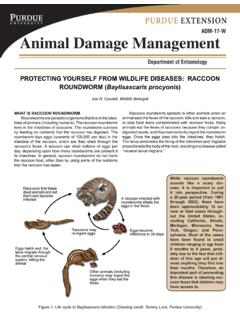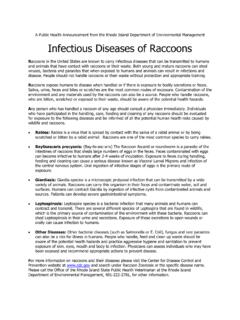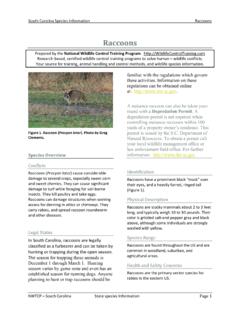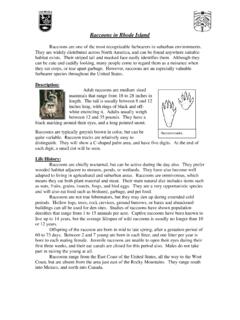Transcription of Trap-Vaccinate- Release Program to Control Raccoon Rabies ...
1 Trap- vaccinate - Release Program to Control Raccoon Rabies , New York, USAS ally Slavinski, Lee Humberg, Martin Lowney, Richard Simon, Neil Calvanese, Brooke Bregman, Daniel Kass, and William OleszkoIn 2009, an outbreak of Raccoon Rabies in Central Park in New York City, New York, USA, infected 133 raccoons . Five persons and 2 dogs were exposed but did not become infected. A trap- vaccinate - Release Program vaccinated 500 raccoons and contributed to the end of the Park, described as an oasis in the midst of an urban jungle, spans 843 acres.
2 raccoons thrive in Central Park, an ideal habitat with an abundance of human refuse as food. Although not actually counted, the estimated Raccoon population in the park is 500. Each year, Central Park receives >25 million visitors, offering ample opportunity for humans and off-leash dogs to be exposed to August 27, 2009, a sick Raccoon collected from Central Park in Manhattan tested positive for Rabies virus, marking the emergence of an enzootic of Raccoon Rabies in Central Park.
3 From December 2009 through December 2011, Rabies test results for 133 raccoons collected in or near Central Park were also positive (Figure 1). The New York City Department of Health and Mental Hygiene (DOHMH) quickly assembled a task force with the objective of developing a response plan. The task force comprised members of the New York City DOHMH, the US Department of Agriculture Wildlife Services, the Central Park Conservancy, the New York City Department of Parks and Recreation, the New York State Department of Health, New York City Animal Care and Control , and the New York State Department of Environmental Conservation.
4 A trap- vaccinate - Release (TVR) plan was developed and implemented. The ProgramThe trap- vaccinate - Release Program goals were to reduce transmission of Rabies among raccoons and prevent human and pet exposure to rabid raccoons . The few examples of Raccoon Rabies epizootics in similar settings often used a point infection Control approach: oral Rabies vaccine, depopulation of up to 80% of the raccoons , and TVR (1 6).For the Central Park outbreak, oral Rabies vaccine was ruled out because of the small but potential risk for vaccinia infections of humans (7,8), given the large volume of park visitors and poor Raccoon seroconversion rates (9% 61%) (9 14).
5 Depopulation was also eliminated because it would have overwhelmed the animal shelter system with demand for humane euthanasia and decapitations and because a national animal welfare organization and the public voiced opposition. Thus, the task force chose TVR. The makeup of Central Park and the surrounding Manhattan area creates a fi shbowl-style habitat; inside the park are acres of ideal living habitat, surrounded by a mass of concrete, roadways, vehicles, and pedestrians, to contain the raccoons .
6 Central Park and 2 small parks in DISPATCHES1170 Emerging Infectious Diseases Vol. 18, No. 7, July 2012 Author affi liations: New York City Department of Health and Mental Hygiene, New York, New York, USA (S. Slavinski, B. Bregman, D. Kass, W. Oleszko); US Department of Agriculture, Rockville, Maryland, USA (L. Humberg, M. Lowney); New York City Department of Parks and Recreation, New York (R. Simon); and Central Park Conservancy, New York (N.)
7 Calvanese)DOI: 1. Location of rabid raccoons in and around Central Park, New York City, New York, USA, December 1, 2009 December 1, 2011. Each dot represents a rabid to Control Raccoon Rabies , New York, USAclose proximity were targeted for 3 rounds of TVR. The public was notifi ed through press releases, posters, fl yers, electronic messaging, and the New York City 311 telephone information service. Community boards, political leaders, and human and animal health communities were notifi ed directly.
8 The DOHMH website was kept 3 rounds of TVR were conducted: February 16 April 7, 2010, September 20 November 5, 2010, and November 28 December 16, 2011. Trapping efforts were focused in Central Park, followed by Morningside and Riverside Parks. Humane cage traps baited with marshmallows and anise oil as a scent attractant were placed in sites that were off limits or of limited access to the public and their dogs. Each trap had a Rabies warning sign with emergency contact raccoons were visually assessed for evidence of injury, illness, or death.
9 raccoons that were ill or injured were humanely euthanized and, along with those found dead, were submitted for Rabies testing at the DOHMH Public Health Laboratory. Healthy raccoons were immobilized in the trap by a squeeze comb, given 1 mL of Rabies vaccine in a thigh muscle, identifi ed by placement of an ear tag, and then released at the capture site. Healthy, tagged raccoons that were later recaptured during the same round of TVR were released, but those recaptured during a subsequent TVR round were each round of TVR, 26 73 traps were set per night, resulting in 3,822 trap-nights (Table).
10 A total of 1,129 raccoons were trapped (range 0 34/night), of which 484 raccoons were vaccinated and 112 were revaccinated. Among 232 raccoons , there were 586 instances of recapture (median 1, range 1 9).During round 1, of 460 raccoons trapped, 237 were deemed healthy, processed, and released (Table). Of 58 raccoons deemed unhealthy or found dead, 11 were Rabies positive; of these, 0/6 were dead, 5/8 were sick, and 6/44 were injured. During round 2, of 459 raccoons trapped, 148 were newly vaccinated, tagged, and released, and 68 were revaccinated.
